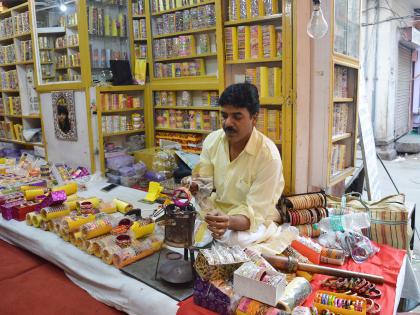Declared a Cottage Industry, Yet Bangle Makers Face Neglect and Insufficient Support From Government In Karnataka
By Anubha Jain | Updated: August 11, 2024 19:22 IST2024-08-11T19:22:00+5:302024-08-11T19:22:00+5:30
Bright-coloured glass bangles fascinate every Indian woman. In traditional functions or wedding ceremonies, women in North Karnataka are fond ...

Declared a Cottage Industry, Yet Bangle Makers Face Neglect and Insufficient Support From Government In Karnataka
Bright-coloured glass bangles fascinate every Indian woman. In traditional functions or wedding ceremonies, women in North Karnataka are fond of wearing solid glass bangles, to match their attires. This is the prime reason owing to which the glass bangle industry is buzzing in this modern era too. Depending entirely on the conventional green, red, and maroon-coloured solid yet simple glass bangle-making business, villagers of Murgod earn their living. Famous as a ‘village of bangles’ Murgod is a small village situated in Karnataka’s Belgaum district. Sanket Chivate, owner of a 65-year-old bangle store in Belgaum in a candid conversation with me said that these simple glass bangles without any work on them are designed by the craftsmen of Murgod, especially for deities and prayer (puja) purposes. These bangle makers craft bangles of different hand sizes and sell these for Rs. 50 per dozen. Sanket said that we as a wholesaler get a toda with 100 bangles of 25 dozen. The wedding season falls from April to June end and from November to December after the Tulsi puja and Diwali, during these months sales of fancy bangles go high. However, green bangle selling remains neutral throughout the year, he added. Similarly, a family called Kajgar from Nesargi village in Belgaum has been in this business since the 1970s. Like this many such families are into this traditional bangle-making business. A few years ago, it was initiated with merely one or two bangle-making units, today with one factory including many such units that increased bangle production here. Even nearby villages in Belagavi and Dharwad districts have small units. With around 20 workers in each bangle-making unit and an annual turnover in crores, these workers work 8-10 hours daily.
Earlier, hundreds of families in these villages worked in the hot furnaces (Bhatti) and fumes. But now machines have changed the scenario, Sanket said. Also, in recent times through innovative techniques such fine products are being crafted like plastic and metal bangles with stone glass bangles completely decorated with stone colour beads & metal balls on them. And, hence, the demand for handmade glass bangles is diminishing gradually. The entire process of making glass bangles involves heating, melting, and shaping which require a lot of accuracy, skill, and time. It is so amazing that these craftsmen are so competent in their skill that by just seeing a woman’s hand, they can set the size of the bangle. I was amazed to see that they work in a limited, small space. A square-shaped set-up made of mud where wood-fired ovens were placed. Bangles are crafted through a meticulous process that begins with melting glass. For melting, a pot is placed in each oven. With the support of iron rods, the workers take out molten glass from the furnace which is drawn into thin tubes, cooled, and cut into the desired lengths, which are then reheated and shaped around a mandrel to form circles. This requires great attentiveness of workers. A delay of a few seconds can make the molten glass of no use.
The craftsmen buy these raw glass pieces to make bangles from Firozabad in UP, Pune, Karad, Miraz, and Satara in Maharashtra. Also, waste glass pieces are recycled and used for making these bangles. Eventually, they sell these products in Belagavi, Dharwad, Haveri, and other Karnataka cities with Maharashtra, Moradabad, and Firozabad in UP. Demanding more substantial support from the government, craftsmen from the glass bangle industry feel that working in extreme heat conditions in closed rooms with a lack of proper ventilation is hazardous for them. It creates respiratory issues and health complications among workers. Though machines and equipment have changed the scenario. However, they strongly believe that education is only a way out, and perhaps the time has come to move on to some other profession. These craftsmen say, "Our children, and grandchildren are getting an education. Seeing the unsatisfactory conditions of hard struggle and less earning in the domain, the younger generation is not interested in learning our traditional art, and cheap plastic bangles are flooding the market. Also, the industry is gripped with mechanization and machines replacing artisans, thereby threatening the livelihoods of these workers.”
Open in app